Welcome to another edition of Five Things I Liked (Or Didn’t Like) This Week. There must have been something in the water across the league over the past seven days, because while this column always highlights delightful oddities that I caught, they aren’t often so delightful or so odd. This week, rarities abounded. There were runners getting hit by throws, wild acrobatics, no-look passes, and even a pitchout. Hot teams and cold teams clashed, errors got compounded, and situations that felt in hand rapidly got away. So keep an eye on the runner at first base, and let’s get started – after my customary thanks to Zach Lowe of The Ringer, who popularized this column format for basketball.
1. Not-Quite-Free Bases
Jarren Duran is off to a slow start to the 2025 season. And while the problems have mostly come at the plate, everything seems a little off. Take this misadventure on the basepaths last Thursday. Duran led off the bottom of the 10th inning with a game-tying single. That made him the winning run, and he immediately started plotting a theft of second base to get into scoring position. Nick Sandlin checked on him:

Then he checked on him again:
That’s two disengagements; Sandlin wasn’t likely to try again. Duran stole 34 bases last year. He’s blazing fast. He was 5-for-5 on the season and had already swiped one in this game. Second base was as good as his. And so the Blue Jays took extreme measures, calling for one of the least-used plays in modern baseball, a pitchout:
OK, now this was getting comical. Two throws over and a pitchout before even throwing Rafael Devers a competitive pitch? The Jays couldn’t afford to pay any more attention to Duran. And you know the classic wisdom – after they try a pitchout, you can steal. So of course, Duran got on his horse on the next pitch. This is as good of a situation as you can imagine for a steal. No disengagements left, righty on the mound, key run in a tie game, elite base stealer on first. Just one problem:

Yeah, “basically uncontested” isn’t quite the same as “uncontested.” Sure, the Jays were limited in what they could do, but it’s not as though they were just going to concede the base. The lack of available disengagements meant that Duran got a huge jump, but Tyler Heineman is still allowed to throw down, and that was a beauty. It wasn’t so much the velocity on the throw – Statcast has Heineman as a solid but not excellent arm, and that throw was right around his average velo. But what a beautiful transfer:

You can see the technique at work here. When Heineman saw Duran on the move, he started rising from his crouch. He caught the ball with both feet already moving to a throwing position, which let him transfer and fire in one motion. And while his throw was to the right of the base, all that did was move Bo Bichette into perfect position to apply a tag:

As far as I’m concerned, Duran did nothing wrong here. But when you’re in a slump, things like this always seem to happen. The other team has perfect execution at the moment where you needed anything less than 100%. The situation that almost always works out in your favor runs into the “almost.” Duran will figure things out – but right now, luck is not on his side.
2. Dodgeball Moves
You’ve seen a play like this a thousand times. A batter – Jorge Polanco, in this case – hits a weak tapper toward first, then gets tagged out:
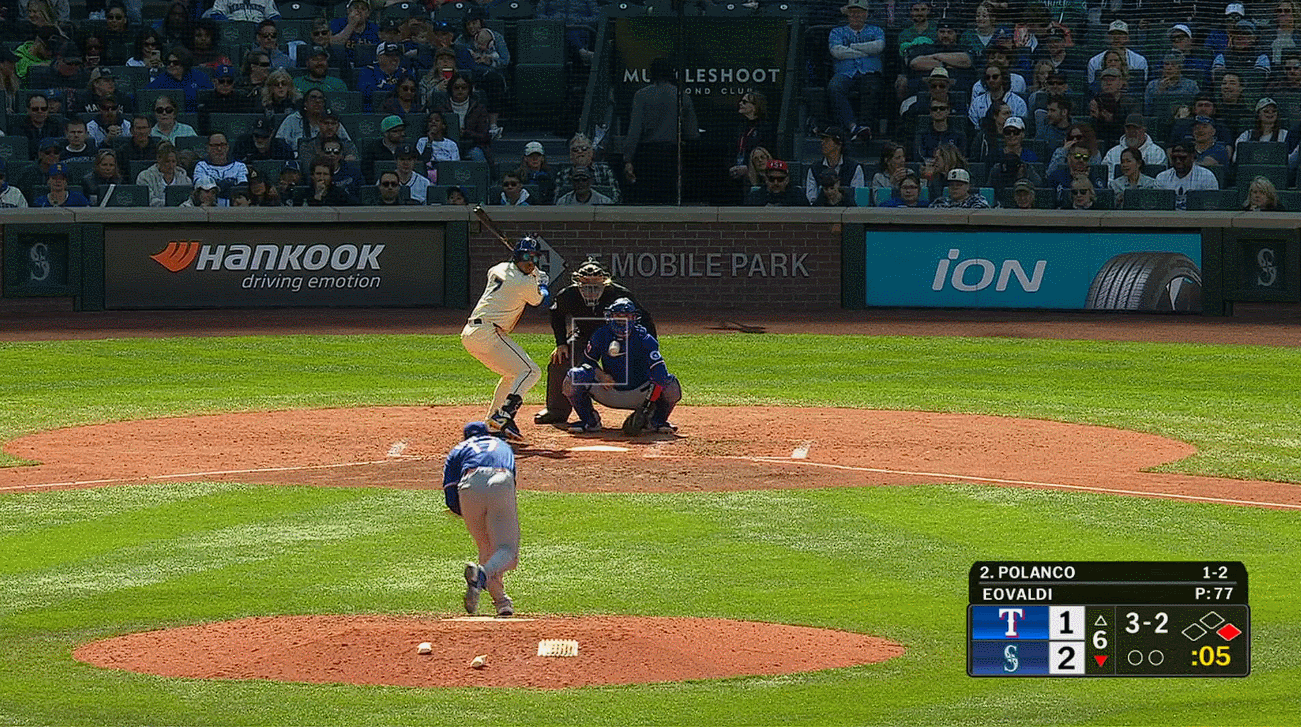
Of course, I didn’t put the tag in that clip, and that’s because things were about to get a little bit wild. Polanco didn’t want to make an out there, and he quickly noticed a few things. One, Jake Burger was in fair territory rather than straddling the basepath. Two, Burger was a little distracted, checking the runner at second as he closed on Polanco. Three, there’s no penalty for trying and failing. And so he hit the spin button:
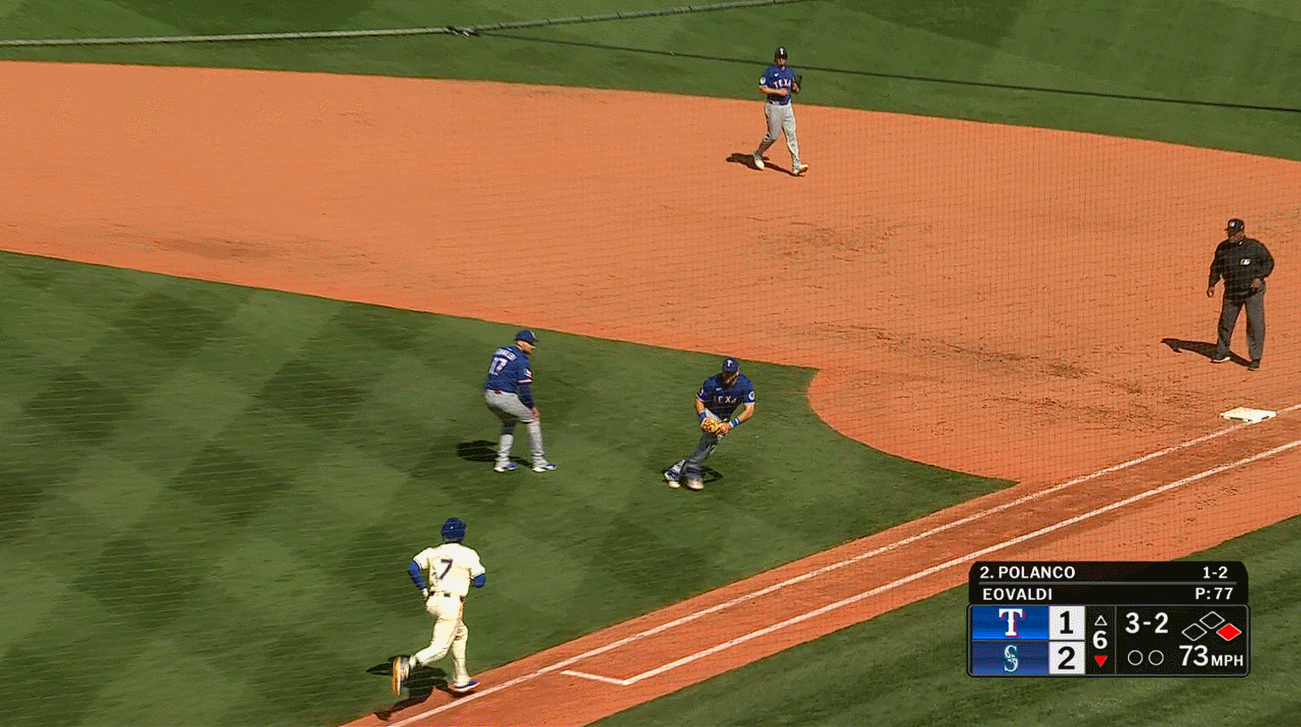
This really shouldn’t work. Fielders make that play all the time. But the combination of a tiny bit of distraction, a perfectly coordinated spin, and more than a little luck made it work. Burger never quite appreciated the importance of securing the tag, so he looked back over to second at an inopportune time, and bam:
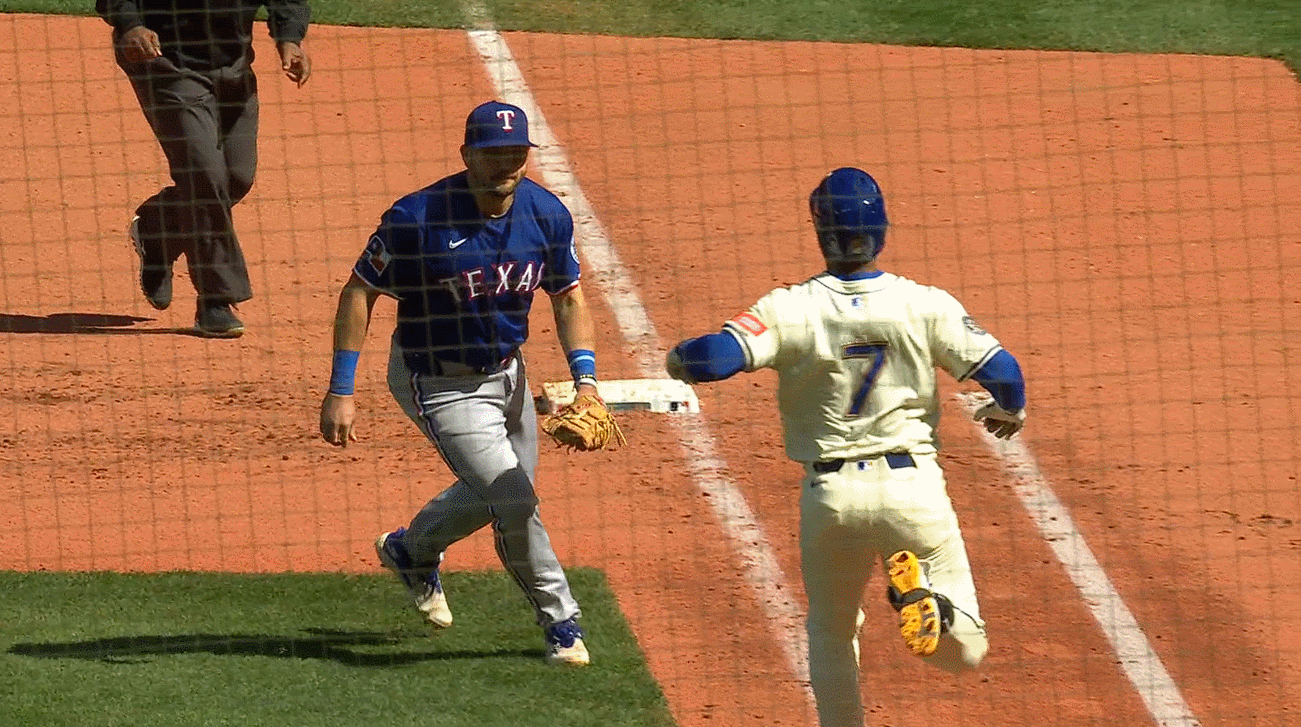
So many things had to go right for Polanco to be safe there. Burger had to try to make the tag outside his body rather than keeping his torso between Polanco and first. He had to look away before Polanco started spinning; otherwise, he’d be able to adjust. The spin wasn’t an automatic success anyway. Look again at how close that came to getting him:
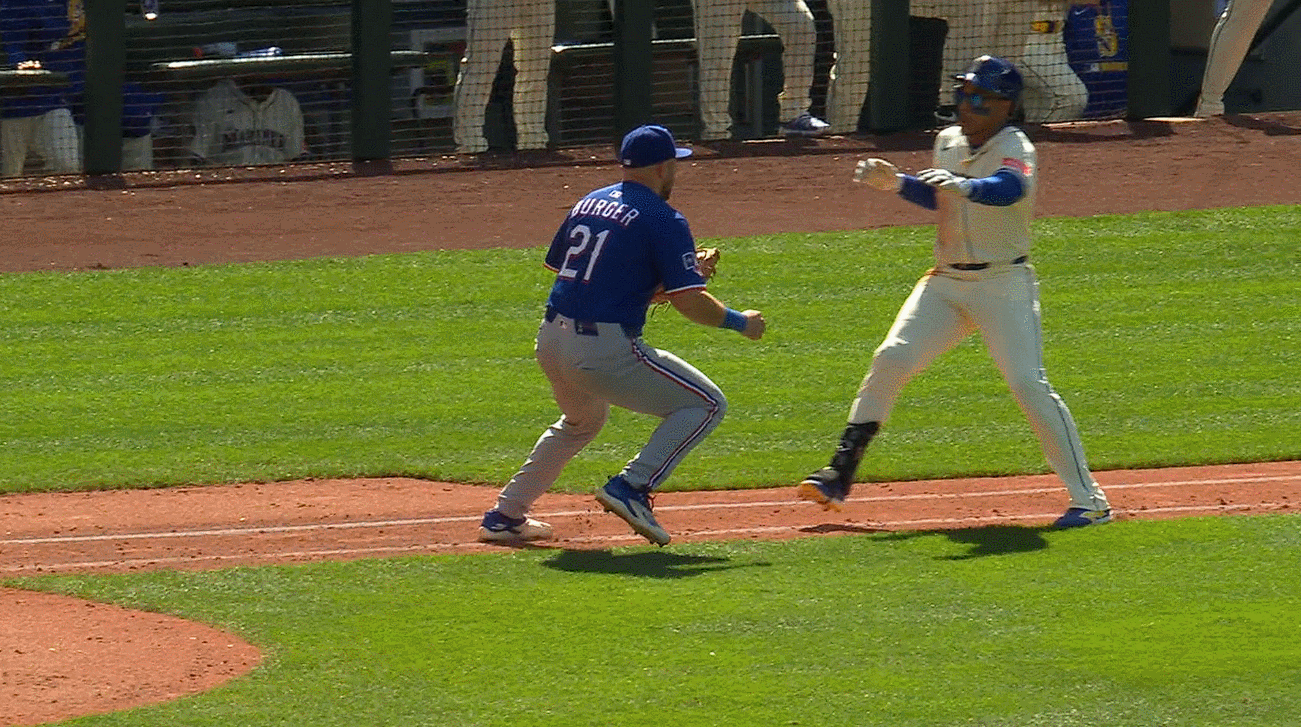
The Rangers challenged, and Bruce Bochy grumped to the umpires a bit, but the outcome was never in doubt. Polanco didn’t leave the basepath to avoid a tag; he avoided a tag right on the basepath. You have to tag the man or the base to make an out there, and the Rangers did neither. Just because it looks different from your average play doesn’t mean it’s not legal.
Why don’t we see spin moves more often? Because they wouldn’t work. Start doing it frequently, and first basemen would never fall for it. This is the kind of trick that only works because no one expects it. The next time Polanco tries a spin, he’s probably going to get a glove in the chest and a “c’mon bro” for his efforts. But this one happened, and it led to a run. Two batters later, a bases-loaded hit-by-pitch scored him to give the Mariners a 3-1 edge. Not exactly how Polanco wanted to reach base, I’m sure, but he’ll take what he can get.
3. Giving 110%
Oh, you like spin moves? You want more basketball-style plays in baseball? I’m with you. So how about a through-the-legs pass?

With Tyler Wade running, that would have been a tough play regardless, but Nico Hoerner didn’t have the luxury of a straightforward play. He charged the ball from his initial position, trying for a standard barehanded snag, but with all of his momentum heading toward home plate, he was at an impossible angle for a throw when he reached the ball:
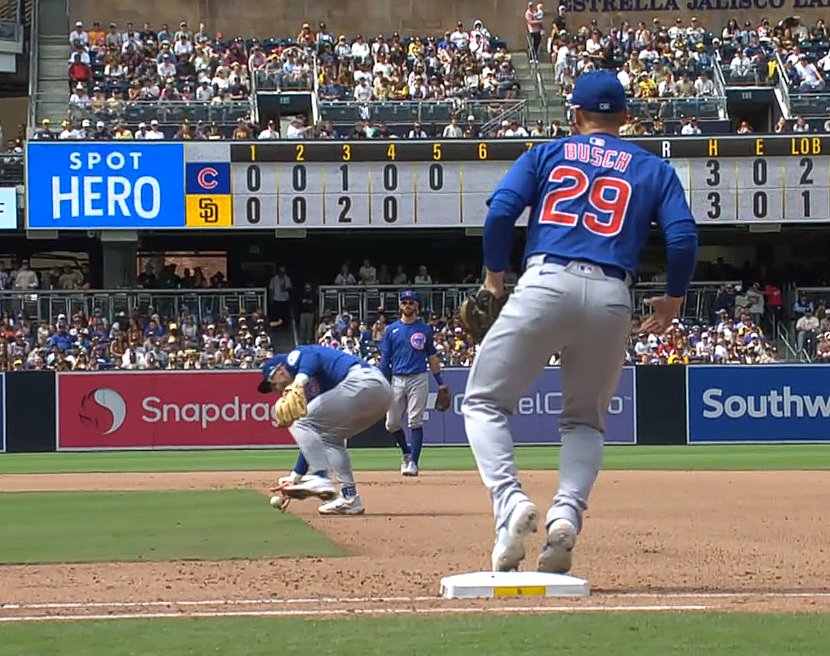
For most fielders, the play would be over right then. Too bad, so sad, can’t make the throw but at least the runner stays on first. But Hoerner could smell an out, and he’s a phenomenal defender, so he improvised:

Too late? Yeah, as it turns out it’s hard to get much force on a through-the-legs throw. Wade was booking it down the line. There’s no way to get your legs into a throw when you’re tossing it through your legs, so Hoerner’s throw was late. But that didn’t make the coordination any less impressive:

If a catcher were running there, this would be one of the defensive plays of the year. Instead, it’s just another line item: “Tyler Wade singles on a ground ball to second baseman Nico Hoerner.” But you have to respect the effort. Hoerner is one of the best second base defenders in the game, and his creativity is second to none.
4. Pitcher Fielding Practice
For whatever reason, my early-season baseball viewing has over-indexed on the Minnesota Twins. They’ve played a few divisional series, and I’ve been keeping an eye on AL Central tilts after last year’s free-for-all. They’ve played the Mets, and I like listening to the Mets booth. And they unveiled a Joe Mauer statue – how was I not going to watch that game? But every time I tune into a Twins game, I see a pitcher sailing a throw:
That’s the first throwing error I remember seeing a Twins pitcher make this year, and it was a howler. I get that Bobby Witt Jr. is fast, but Griffin Jax didn’t need to hurry there. He knew it; he babied the throw to first rather than go all out. He just flat out missed. Witt made it all the way to third on the error, scored on the next play, and provided the decisive run in a 2-1 Royals victory.
After you’ve seen one throwing error, you can’t stop seeing them. Louis Varland pulled a pickoff throw wide (side note, I love his reaction here):
In the next series, chaos reigned. Justin Topa airmailed one of the easiest throws he’ll attempt all year:

The very next inning, Jorge Alcala tried to do too much when faced with an excellent bunt:
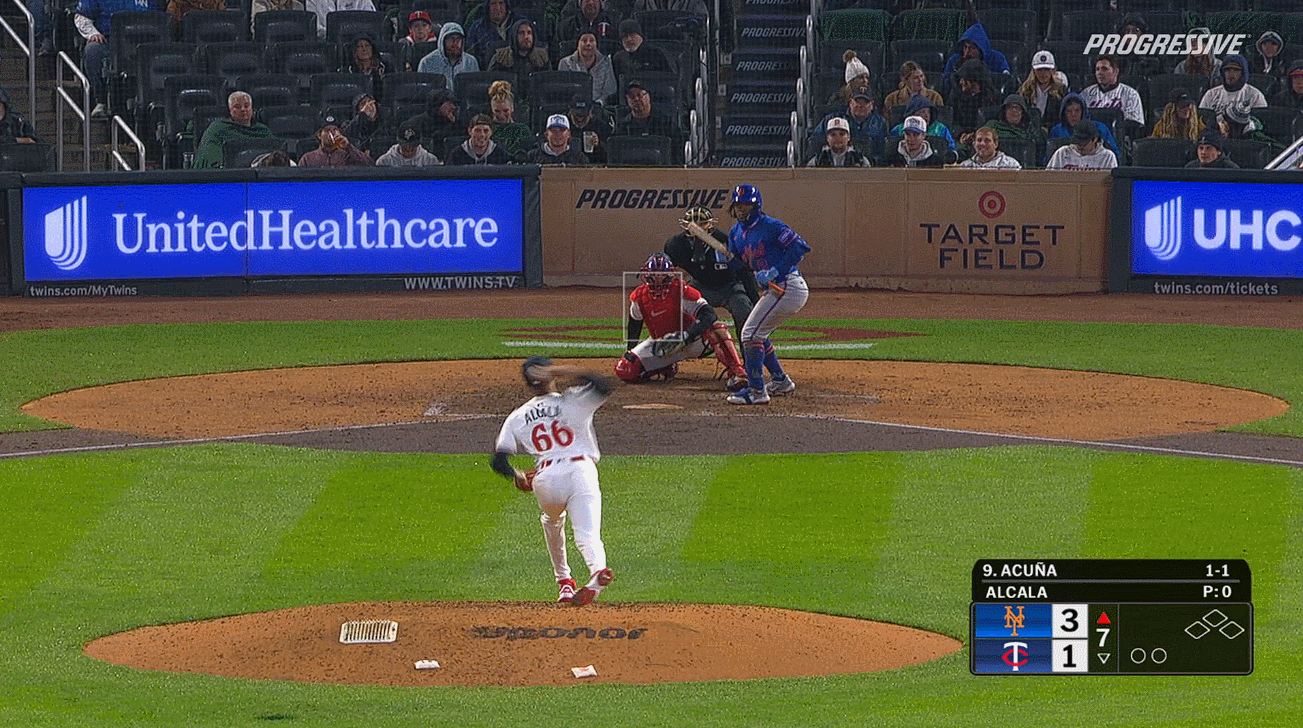
That’s six throwing errors charged to Twins pitchers so far this year; no other team has more than three pitcher errors, period. And the sloppiness has even crept over to the actual fielders. Ever seen a second baseman forget that he’s playing baseball and not dodgeball? Now you have:

It’s been a tough start to the season for the Twins. After a late-season collapse in 2024, they’re picking up where they left off, five games below .500 already. To be clear, the season’s far from over. We give the Twins nearly 40% odds of reaching the playoffs, second best in the AL Central. It’s April! There’s plenty of time to turn it around. But it’s been a sloppy, sloppy start to the year in Minneapolis, and the strange pitcher-fielding contagion sweeping the team isn’t helping.
5. Houston’s Strike Zone Box
I have a love/hate relationship with strike zone boxes on TV broadcasts. It makes the game more accessible, no doubt, and it’s a lot easier to follow the cat and mouse game of locations and pitch types when you can see where specifically the ball crosses the plate. But they break immersion and take away from my appreciation of the beauty of a breaking ball in flight. Where’d the ball end up? I stopped looking because my eyes were focused on the white box.
Through the years, broadcasts have tried different methods of making the strike zone less distracting. They’ve made the lines thinner, fainter, or even gently shaded the area of the zone rather than draw lines at all. But I like the Astros broadcast’s efforts to find a happy medium in strike zone boxes, and I hope more teams will emulate this method. Here’s the Angels broadcast from a Josh Hader slider last Sunday:
That was a nice pitch, right on the outside edge, but I lost track of it when the dot came up, intersecting with the strike zone line. That’s just the deal we’ve made with baseball broadcasts – you’ll see where the pitch is, but it’ll be a bit distracting. But look at how Houston’s broadcast showed it:
Removing some of the box completely changes how I perceive the pitch. Now I can still see the edges of the strike zone, but that jarring dot-on-line overlay doesn’t take me out of the action the same way. Less visual clutter means an easier time following the pitch, and there’s still enough strike zone demarcation to understand that the pitch was right around the edge, a close one with tons of left-right movement.
The muted color scheme of the minimalist zone also helps keep me in the game. This sweeper to Mike Trout clipped one of the (drawn on) corners, but with fewer and thinner lines, there’s just less distraction even when the ball intersects with the on-screen graphics. The superimposed box breaks immersion; making it less obvious does wonders for the presentation of the game, at least for me:
I’m sure that everyone’s taste is different. I know fans who love the strike zone box and couldn’t imagine going to a world without one. I’m sympathetic to their arguments, because baseball with no strike zone box is a much tougher sport to follow for casual observers who aren’t deeply in tune with the nuances of the game and the shapes of each pitch. But I hope more broadcasts opt for this less-intrusive box. I come away from every Astros game thinking about it, which is the highest compliment I can think of for their broadcast team. Great work, Space City Home Network.

